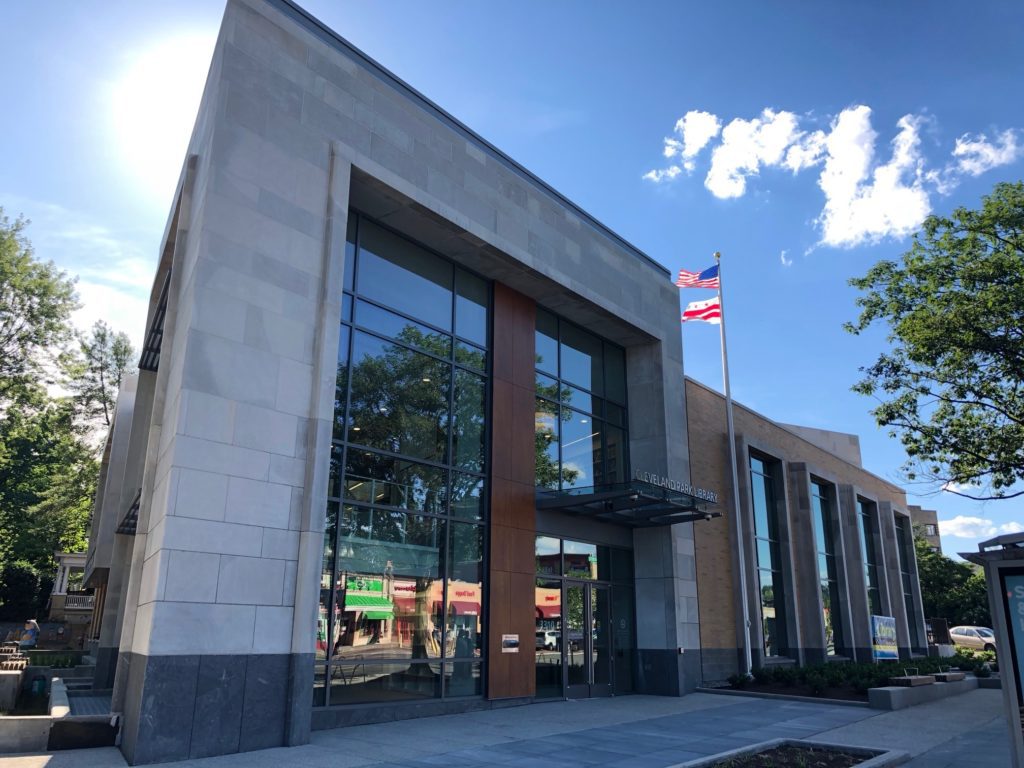Stunning New Cleveland Park Library Opens
By • June 18, 2018 0 1563

Mayor Muriel Bowser cut the ribbon at the stunning new Cleveland Park Library Saturday morning, June 16, before a packed crowd of residents and officials. The construction of the modernistic building at the corner of Macomb Street and Connecticut Avenue had been observed by neighbors and Connecticut Avenue drivers and joggers for almost two years.
The new library’s walls of windows, balconies and even an enclosed reading garden attest to the open, natural-light theme of the design, in total contrast to the original 1953 structure, demolished in 2017.
“We know how much our neighborhoods change, our culture changes. The way that people interact with one another changes as well,” said Bowser at the opening ceremony. The layout and furnishings of the spacious 27,000-square-foot library reflected that with its multiple lounges and work areas, airy book stacks and flexible meeting rooms. And, of course, all are connected and equipped with the latest wireless and visual communication technology.
Almost all the multiple styles of chairs, study tables and desks throughout the library contain individual electric outlets and computer portals. “Since almost everyone brings their own laptops and mobile devices, we give them ample space for that use,” explained Richard Reyes-Gavilan, executive director of the DC Public Library, who gave The Georgetowner a one-on-one tour of the facility June 12. “But we also have laptops we can give to those who don’t have them.”
Groundbreaking for the new building was in April of 2017. “With the June 16, 2018, opening we are happy to announce that the entire project has been completed ahead of schedule and under budget,” Reyes-Gavilan said. But it was the result of years of meetings and constant communication with community leaders, library users and residents.
“One of the needs that kept coming up in planning sessions was for community meeting rooms for large and small community groups,” he said. As a result, not only was a large airy meeting room with flexible walls and multiple visual aid equipment provided on the first floor, but the basement was reconfigured to provide several more meeting rooms. They are also available for youth and children’s play activities.
The children’s reading area takes up a good third of the ground floor area. It is colorfully decorated and equipped with multiple low shelves of books, reading areas with padded benches and access to the library’s enclosed and landscaped reading patio. One construction obstacle provided a unique decorative theme in the area: a new weight-bearing pillar needed to be constructed in the back area of the children’s room. It became the frame of a decorative reading tree that livens up the entire section.
An open lounge with couches and big chairs adjoins the children’s section in front. “It’s not only for patrons, but we designed it so that parents and caretakers who want to keep their eye on their kids in the library section can also give them some independence,” Reyes-Gavilan pointed out.
This is not the old library in other ways as well. A wall of shelves for on-call books next to the entrance faces a completely online check-out system, so that patrons can come in quickly and pick up their books placed on hold without standing in line.
“Quiet and Silence Please” signs are missing. Natural noise is allowed everywhere, although the upstairs reading room and sections of fiction and nonfiction books will be maintained as more of an adult quiet area. Similarly, patrons will be allowed to bring in snacks and drinks, even coffee in moderation.
Almost entirely missing from the entire library system are warnings about due dates and fines for missing items. “We don’t want to discourage people, especially children, from coming to the library and taking out books because they might be fearful of paying a fine for a misplaced book,” said Reyes-Gavilan. “We’ve experienced too often in the past how, maybe years later, a youth’s room is finally being cleaned out and all of a sudden, there are those missing library books nobody could find. They are then returned.”
But one thing remains the same. In 1953, the then-new Cleveland Park Library represented “the culmination of decades of community activism in support of the placement of a public library in this Northwest community. The present site on Connecticut Avenue was referred to as the ‘library lot’ as early as 1913. When it opened, the Cleveland Park branch, one of the first of the D.C. libraries to be designed in a spare, Modernist style, was one of the largest in the D.C. Public Library system.”
One big difference is the cost. In 1953, the Cleveland Park library building was designed by Municipal Architect Merrell A. Coe; the site of the library was purchased for $75,000. The Connecticut Avenue Citizens Association raised $30,000, and the rest was appropriated by Congress. Today’s ultra-modern facility was designed and built by Perkins Eastman and Gilbane. It cost nearly $20 million, and most of the funds were from municipal coffers.

